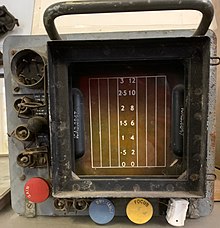


Monica Mk III Indicator Unit
| |
| Country of origin | the United Kingdom |
|---|---|
| Introduced | June 1942[1] |
Monica was a range-only tail warning radar for bombers, introduced by the RAF in June 1942.[2] Officially known as ARI 5664,[3] it operated at frequencies of around 300 MHz (on the boundary between VHF and UHF). The system was also used by the US Army Air Forces, under the name AN/APS-13, and the nickname Archie.
Monica was developed at the Bomber Support Development Unit (BSDU) in Worcestershire.[citation needed] After the Luftwaffe became aware of Monica from a crashed bomber, German scientists developed a passive radar receiver, named Flensburg (FuG 227). From early 1944, FuG 227 was used by nightfighter crews to home in on Allied bombers using Monica.[4] However, on the morning of 13 July 1944, a 7.Staffel/NJG 2-flown Junkers Ju 88 G-1 nightfighter equipped with Flensburg mistakenly landed at RAF Woodbridge. After examining the Flensburg equipment, the RAF ordered Monica withdrawn from all Bomber Command aircraft.[5] An AN/APS-13 was used as a radar altimeter during the Atomic bombings of Hiroshima and Nagasaki by the 509th Composite Group, USAAF.
|
RAF strategic bombing during the Second World War
| |
|---|---|
| Overviews |
|
| Leaders |
|
| Campaigns |
|
| Operations |
|
| Aircraft |
|
| Technology |
|
| Tactics |
|
| Units |
|
| See also |
|
This RAF article is a stub. You can help Wikipedia by expanding it. |